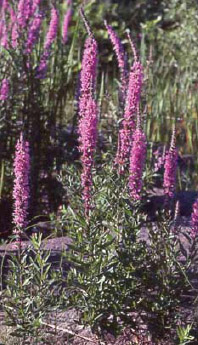How do invasive plants or animals spread into Manitoba?
Increased global trade and travel have created many new pathways for the international and incidental spread of invasive aquatic species. The growing trade in aquatic ornamental plants for water gardening and aquariums is also cause for concern. Many of the currently known invasive exotic plant species in North America have been imported and planted as ornamentals. The invasive aquatic plants, Purple Loosestrife and Saltcedar, serve as examples of this.
Dispersal
Humans are most often directly responsible for introducing a species to a new region, whether intentionally or unintentionally.
Hitchhikers
Species can become unintentionally transported globally, by catching a ride in places like ship ballast water, or locally, by attaching to boats or other equipment used by anglers and hunters.
Imported: Intentionally imported species are not usually intended for widespread distribution into the environment.  However, plants, brought in for gardeners as ornamentals, or exotic pets can become invasive pests in regions where they were never intended to be released.
However, plants, brought in for gardeners as ornamentals, or exotic pets can become invasive pests in regions where they were never intended to be released.
Illegal Trade
Illegal smuggling/trading of fruits and vegetables across borders can introduce not only potentially harmful new plant species but also any insects and parasites that may live in them.
Natural Dispersal
Through time, species are able to expand ranges naturally, establishing in areas they previously did not exist in.
Stages of Invasion Entry
Species is introduced to a new region.
Establishment: Species avoids immediate local extinction, begins to multiply and create viable breeding population.
Spread: Population grows to sufficient level to afford expansion into surrounding suitable habitats.
Impact: Population levels continue to increase, breeding population established. Competition with native species becomes serious concern. Not all species that are introduced become invasive pests. Some species are unable to survive in their new habitats, and quickly die off. Some species can only sustain themselves in new habitat through constant introductions. Species that do thrive and become a threat are usually habitat generalists, and are able to survive under a wide range of tolerances.
Prevention, early detection and rapid response are critical for saving habitats from invasive species. You can do your part by... (more)

© Copyright 2004-2025 - CMS Made Simple
This site is powered by CMS Made Simple version 1.4.1


